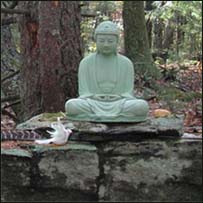|
|
 |
Please support Dharma Seed with a 2025 year-end gift.
Your donations allow us to offer these teachings online to all.

|

|

|
The greatest gift is the
gift of the teachings
|
|

|
| |
|
Dharma Talks
|
2025-06-24
Q and A
56:50
|
|
Ajahn Sucitto
|
|
|
00:18 Q1 It said that the awakened ones attained nibbana through mindfulness of the body. What about going through the formless realms? How do you maintain awareness of the body until nibbana? 13:02 Q2 I consider that for nibbana it requires mindfulness to be present every second, not just a while but continuously. This may be uncomfortable, perhaps we should bite the bullet and speak it out. On the other hand it's common when one has a strong practice for extended hours, for a few hours to think maybe I'm close? 25:35 Q3 Can you say more about the cultivation of the measureless states. 34:39 Q4 Ajahn Chah says something like happiness and unhappiness are both suffering and Buddhism seeks peace not happiness. Could you help me hear that as less of a bummer? 37:32 Q5 A person mentions that both teachers on the retreat like each other and are happy not just peaceful. Could you speak about this? And, why do you bother to dress your salad? 40:57 Q6 Regarding the spinal, sense could you please expand on this as a place of security and refuge, neutrality and Buddha. Does it have anything to do with the chakras? 48:35 Q7 Can you talk about practice to forgive oneself and others?
|
|
Cittaviveka
|
|
|
2025-06-22
How do I establish and know sati sampajañña?
28:04
|
|
Ajahn Sucitto
|
|
|
Ajahn responds to several questions around the themes: Is it necessary to have an attitude of sanctity or divinity when one is mindful in the sati sampajanna way? Is it possible to get anywhere in the practice without being ordained? How long should I sit and what particular process should I go through? Will I arrive at a certain recognizable state?
|
|
Dhamma Stream Online Sessions
|
|
|
2025-06-18
Q and A
57:31
|
|
Ajahn Sucitto
|
|
|
Q1 00:52 When you're walking around and brushing your teeth what's your experience of the sense world and nibbana? I'd like to experience more beauty and sacredness in the sense world and cultivate a relationship with the transcendent, but it feels so out of reach; Q2 17:43 Recently I listened to a talk by Ajahn Tanissaro and he said he didn't know any practitioner in the West who was a stream enterer. I was disheartened. Can you say something about this? Q3 28:09 can you give some advice on cell phones and technology please? They drain my energy quickly. Q4 35:34 (several questions) In mindfulness of breathing, does one proceed sequentially through the 16 phrases, or pick up the steps that seem to fit with whatever seems to be arising. Why is it presented as a graduated training? Also, can you speak about releasing the heart? Q5 44:18 What are the differences between attention and awareness? What are their Pali terms? Q6 49:42 "One reviews the extent to which one's mind is liberated..." In the Book of the 5s. If one's mind is non-liberated how do you go about it? Q7 52:59 How to relate when resistance arises in practice from feeling blocked, to discouraged or lost etc etc etc.
|
|
Insight Meditation Society - Forest Refuge
:
One Month Retreat at the Forest Refuge
|
|
|
|
|